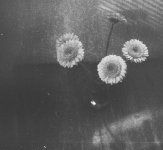dave61
Established
Well....have to confess I've never had a Super Ikonta and a Mamiya-Six in front of me at same time to compare. I can't/won't pay USD~$500-600+/- for a Super Ikonta or USD$2200 for a Bessa III. IMHO, in today's market, Super Ikontas and 'modern' 120 folders from Fuji and Voigtlander aren't good 'bang for the buck'.
ZNIV: If you can afford it, a late model Zeiss Super Ikonta Type 3 or 4 is great (but expensive) camera, USD~$300+ (and up). More budget-conscious, try Mamiya Six Type 4 (1947) or later (for auto frame counting): USD~$200+/-; handles great; beefy front standard; 1 sec-1/500th Seikosha-Rapid shutter; bright RF/VF; reliable film advance/counter mechanism; unit focus (not front element); great focusing system. 2 for sale right now at that auction site.
Iskra 1 (1964): USD~$150+/-; built like T-37 tank; razor-sharp multi-coated lens; strong accurate shutter; m/x-sync + PC socket; big, bright RF/VF; unit-focusing lens; rounded smooth body shape; lens threaded for series 5 filter; fast automatic film loading + counting-no ruby window; has lugs for neck-strap; 1/2 price copy of late-'50's Super Isolette. On the bay or go to www.fedka.com, FSU camera specialist in NYC, USA.
Consider: 1950's 6x6cm Agfa Isolette III/Ansco Speedex III; 6x9cm Agfa Record III; USD~$40-140+/-. depending on lens (Solinar is best); 1950's Zeiss 'Mess' Ikonta USD~$100-175 (look for one with Tessar). All these have built-in, uncoupled RF's. Super Isolette, late 50's, equal to or better than Super Ikonta, top of Agfa line, all the bells and whistles, USD~$300+ (and up).
Also: Moscva 3, 4 and 5 from FSU; all have coupled RF's; copied from/evolved out of Super Ikontas; were produced into the 1980's; USD~$100-200+/-.
With most German 120 folders, I and II are usually cheaper models. III and 'Mess' have built-in UNcoupled RF's. 'Super' has coupled RF.
My advice, try to find more "modern" ('50's and newer) models, with: accessory shoe for clip-on light meter; 4 element f/3.5 lenses; x-sync; 1 sec.-1/500th shutters; better, brighter RF/VF's; auto or semi-auto film advance/frame counting. If you plan on shooting with it regularly, I don't recommend buying any pre-1947 folder.
ZNIV: If you can afford it, a late model Zeiss Super Ikonta Type 3 or 4 is great (but expensive) camera, USD~$300+ (and up). More budget-conscious, try Mamiya Six Type 4 (1947) or later (for auto frame counting): USD~$200+/-; handles great; beefy front standard; 1 sec-1/500th Seikosha-Rapid shutter; bright RF/VF; reliable film advance/counter mechanism; unit focus (not front element); great focusing system. 2 for sale right now at that auction site.
Iskra 1 (1964): USD~$150+/-; built like T-37 tank; razor-sharp multi-coated lens; strong accurate shutter; m/x-sync + PC socket; big, bright RF/VF; unit-focusing lens; rounded smooth body shape; lens threaded for series 5 filter; fast automatic film loading + counting-no ruby window; has lugs for neck-strap; 1/2 price copy of late-'50's Super Isolette. On the bay or go to www.fedka.com, FSU camera specialist in NYC, USA.
Consider: 1950's 6x6cm Agfa Isolette III/Ansco Speedex III; 6x9cm Agfa Record III; USD~$40-140+/-. depending on lens (Solinar is best); 1950's Zeiss 'Mess' Ikonta USD~$100-175 (look for one with Tessar). All these have built-in, uncoupled RF's. Super Isolette, late 50's, equal to or better than Super Ikonta, top of Agfa line, all the bells and whistles, USD~$300+ (and up).
Also: Moscva 3, 4 and 5 from FSU; all have coupled RF's; copied from/evolved out of Super Ikontas; were produced into the 1980's; USD~$100-200+/-.
With most German 120 folders, I and II are usually cheaper models. III and 'Mess' have built-in UNcoupled RF's. 'Super' has coupled RF.
My advice, try to find more "modern" ('50's and newer) models, with: accessory shoe for clip-on light meter; 4 element f/3.5 lenses; x-sync; 1 sec.-1/500th shutters; better, brighter RF/VF's; auto or semi-auto film advance/frame counting. If you plan on shooting with it regularly, I don't recommend buying any pre-1947 folder.
Last edited:


